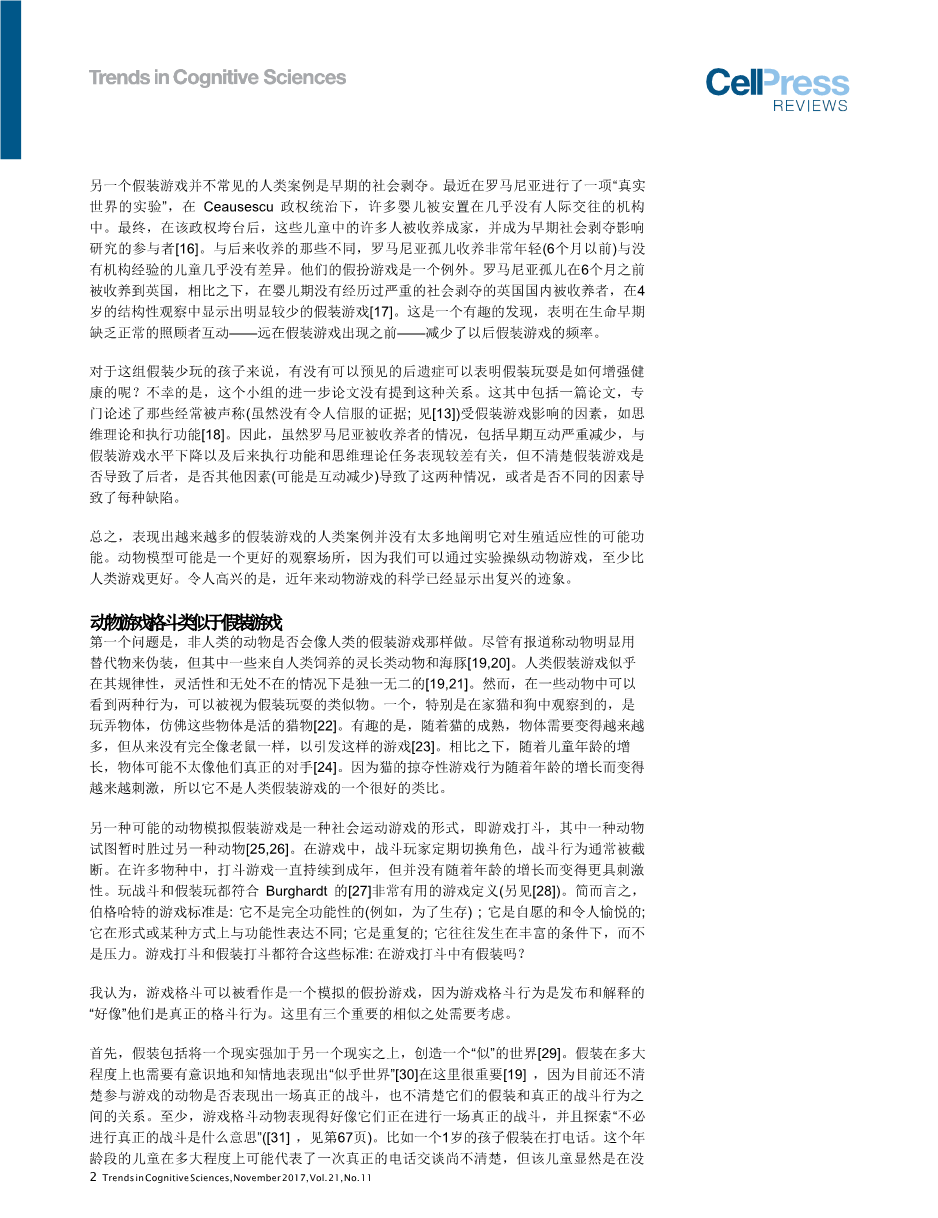

英语原文共 23 页,剩余内容已隐藏,支付完成后下载完整资料
Opinion
Why Do the Children (Pretend) Play?
Angeline S. Lillard1,*
Pretend play appears to be an evolved behavior because it is universal and appears on a set schedule. However, no specific functions have been deter- mined for pretend play and empirical tests for its functions in humans are elusive. Yet animal play fighting can serve as an analog, as both activities involve as-if, metacommunicative signaling and symbolism. In the rat and some other animals, adaptive functions of play fighting include assisting social behavior and emotion regulation. Research is presented suggesting that pre- tend play might serve similar functions for humans.
The Conundrum of Pretend Play
Pretend play is a signature behavior of early childhood. Children pretend to be other people,that one object is another, and even that nonexistent things exist – all apparentlywith full knowledge of what the real situation is. Pretend play usually begins with object substitution at around 12–18 months of age, peaks at around 3–5 years with pretend identities and complex social situations [1,2], and ceases altogether (on average) at 11 years, although some people continue to pretend play into adulthood [3]. For example, adults sometimes pretend to be famous people going about their business. In addition, certain recreational adult behaviors (theater acting, art appreciation) have been argued to be a form of pretend play [4]. In addition to its predictable developmental schedule, pretend play is culturally universal [5–7]. Although the frequency and content of pretend play vary across cultures, its occurrence and basic schedule do not. Pretend play occurs even in settings where parents discourage it, although its schedule is slightly delayed [8,9].
These two features – a predictable developmental sequence and universality – suggest an evolved behavior. Current thinking on the evolution of play generally is that it arose indepen- dently and sporadically across the animal kingdom (it occurs in five of 30 phyla) under specific conditions and has come to serve different adaptive roles for different species [10]. If pretend play is adaptive in humans, to what ends? One possibility is that it serves (or, at a time in our evolutionary past, served) reproductive fitness directly, but an alternative is that pretend play naturally co-occurs with some other fitness-enhancing capacity, like the ability to use symbols. That is, is pretend play a human-typical adaptation or is it a byproduct of other, unique adaptations present in humans? With humans, of course, the possibility of running an experi- ment to test hypotheses on this point is limited. We cannot assign children randomly to a lsquo;no- pretend-playrsquo; condition because pretend play arises spontaneously. We can look at what happens when there is more versus less pretend play, but such studies have yielded inconsis- tent results and do not address the possibility that there is a baseline level beyond which any amount of pretend play yields benefits [11].
Natural Human Experiments Associated with Variation in Pretend Play
Still, it is helpful to consider natural experiments where pretend play is less frequent or even absent. Lack of lsquo;varied, spontaneous, make-believe playrsquo; was diagnostic for autism in the previous edition of the Diagnostic and Statistical Manual of Mental Disorders (DSM) [12]; recently, both the diagnosis and the criteria changed somewhat, so in the DSM V lack of lsquo;shared symbolic playrsquo; became a diagnostic criterion for lsquo;autism spectrum disorderrsquo; (ASD) [13]. However, because ASD is a very complex disorder that manifests in myriad ways in different people it is unlikely to reveal the selective value of pretend play. For example, pretend play might be lacking in children with autism because of motivation rather than ability; one study found that many children with autism could pretend when specifically instructed to do so [14]. However, this does not mean that all non-pretending ASD children fail to pretend because they lack motivation. As research discussed later suggests, early pretending is facilitated by reading othersrsquo; social communicative cues. ASD also involves social-communicative difficulties; namely, reduced ability to interpret social signals [15]. Inability to read social signals might diminish pretend play. Alternatively, the lack of pretend play among ASD children might give rise to further social-communicative difficulties – or both, or neither. ASD is problematic as a natural experiment in revealing the functions of human pretend play.
Another human case where pretend play is infrequent is early social deprivation. A recent lsquo;real- world experimentrsquo; occurred in Romania, where under the Ceausescu regime many babies were placed in institutions where they experienced very little human interaction. Eventually, after the regime fell, many of these children were adopted into families and also became participants in research on the effects of early social deprivation [16]. Unlike those adopted later, Romanian orphans adopted very young (before 6 months) show few differences from children without institutional experience. Their pretend play is an exception to this. Romanian orphans adopted to the UK before 6 months of age, compared with within-UK adoptees who did not experience severe social deprivation in infancy, showed significantly less pretend play in a structured observation at 4 years old [17]. This is an interesting finding in suggesting that absence of normal caregiver interactions very early in life – well before the appearance of pretend play – reduces the frequency of pretend play later.
For this group of children who pretend play less, are there predictable sequelae that might suggest how pretend play enhances fitness? Unfor
剩余内容已隐藏,支付完成后下载完整资料
资料编号:[269330],资料为PDF文档或Word文档,PDF文档可免费转换为Word


